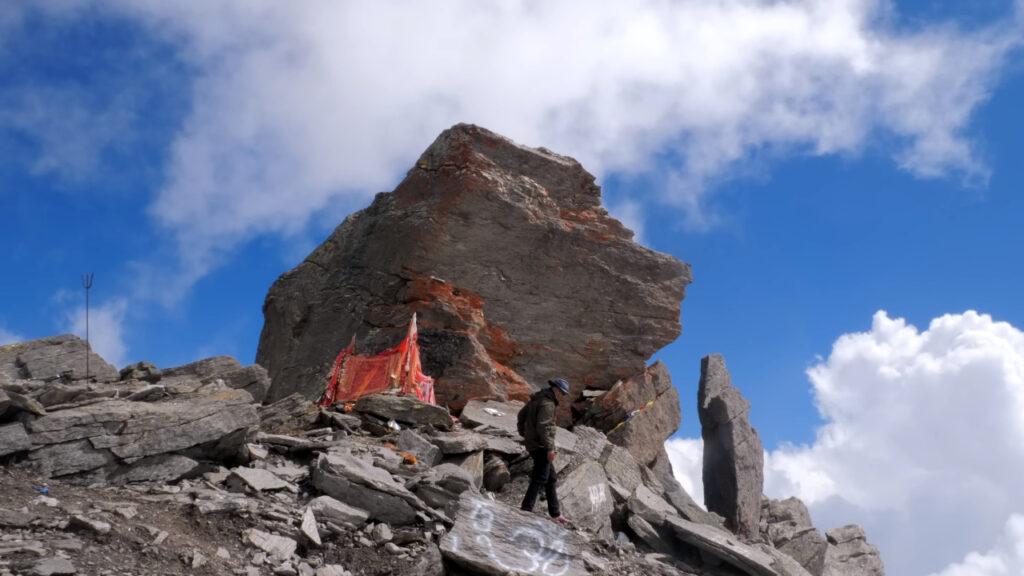Manimahesh Temple is a revered pilgrimage site dedicated to Lord Shiva. Sacred temple is part of the famous Manimahesh Yatra, attracting thousands of devotees each year who seek spiritual solace and the blessings of the deity. Journey to Manimahesh Temple is not just a spiritual quest but also an opportunity to explore the stunning natural beauty and cultural heritage of Himachal Pradesh.

Manimahesh Temple History
Manimahesh Temple, dedicated to Lord Shiva, is a significant pilgrimage site nestled in the Chamba district of Himachal Pradesh. Temple is part of the revered Manimahesh Yatra, which attracts thousands of devotees annually. To legend, Lord Shiva created Manimahesh after marrying Parvati. Temple and the nearby Manimahesh Lake hold immense spiritual significance, with many believing that a dip in the lake’s holy waters can cleanse one of all sins.
Manimahesh Temple Location
Temple is situated near Manimahesh Lake, at the base of the Manimahesh Kailash Peak in the Pir Panjal Range of the Himalayas. Exact coordinates are approximately 32.3950° N latitude and 76.6372° E longitude. Remote location adds to the temple’s mystical allure, surrounded by breathtaking natural beauty.
Location: M2QQ+F7F, Sanghnai, Himachal Pradesh 177205
Manimahesh Temple Photo/Images


Best Time to Visit Manimahesh Temple
Best time to visit Manimahesh Temple is between May and September. During these months, the weather is pleasant, making the trek to the temple more manageable and enjoyable. Also coincides with the annual Manimahesh Yatra, which takes place in August and September, attracting thousands of pilgrims.
Temperature and Weather
- May to June: Temperature ranges from 15°C to 25°C (59°F to 77°F). The weather is generally mild and pleasant, with clear skies and moderate temperatures, making it ideal for trekking and outdoor activities.
- July to September: Temperature ranges from 10°C to 20°C (50°F to 68°F). Experiences occasional rainfall, which can make the trek a bit challenging but also adds to the lush greenery and scenic beauty of the region. The weather remains cool and refreshing.
Seasons
- Spring (March to April): Region starts to thaw from the winter chill, and the landscape begins to bloom. Trek routes may still be covered in snow, making it less ideal for trekking.
- Summer (May to June): Best time for trekking, with pleasant weather and clear skies. Natural beauty of the region is at its peak, with vibrant flora and fauna.
- Monsoon (July to September): While the monsoon brings occasional rains, it also enhances the beauty of the region with lush greenery. Manimahesh Yatra takes place during this time, adding a spiritual and festive atmosphere.
- Autumn (October to November): Weather starts to cool down, and the region prepares for winter. Trek routes remain accessible, but the temperatures begin to drop.
- Winter (December to February): Region experiences heavy snowfall, making the trek routes inaccessible. Period is not recommended for visiting Manimahesh Temple.
Tips for a Smooth Visit
- Plan Ahead: Book your accommodations and travel arrangements in advance, especially during the peak pilgrimage season.
- Check Weather Updates: Keep an eye on the weather forecast to ensure a safe and comfortable trek.
- Pack Accordingly: Carry warm clothing, rain gear, and trekking essentials to prepare for varying weather conditions.
Visiting Manimahesh Temple during the recommended months offers a perfect blend of spiritual fulfillment and natural beauty, making it a memorable experience for pilgrims and trekkers alike.
How to Reach Manimahesh Temple?
Reaching Manimahesh Temple involves a combination of travel modes:
- By Air: Nearest airport is Kangra Airport in Dharamshala, approximately 180 km from Bharmour.
- By Rail: Closest railway station is Pathankot Cantt, about 180 km from Bharmour.
- By Road: Buses and taxis are available from major cities like Pathankot, Dharamshala, Dalhousie, and Chamba to Bharmour.
- Trek: From Bharmour, you can travel to Hadsar by local taxi or bus. Trek to Manimahesh Temple starts from Hadsar, covering a distance of about 13 km. Trek is challenging but offers stunning views of the surrounding landscapes.
Manimahesh Temple Height
Manimahesh Kailash Peak, near which the temple is located, stands at an impressive height of 5,653 meters (18,547 feet). Temple itself is situated at a lower altitude, but the trek to the temple and lake involves significant elevation gain, making it a rewarding experience for trekkers and pilgrims alike.
Manimahesh Temple Nearby Places
- Bharmour – 13 km
Known for its ancient temples and the starting point of the Manimahesh Yatra. - Chaurasi Temple Complex – 13 km
Located in Bharmour, this complex houses 84 ancient temples dedicated to various deities. - Hadsar – 13 km
Base camp for the Manimahesh Yatra, known for its natural beauty. - Chamba – 60 km
Historic town known for its temples, palaces, and the Bhuri Singh Museum. - Dalhousie – 120 km
Popular hill station with colonial architecture and lush green landscapes. - Khajjiar – 110 km
Often referred to as the “Mini Switzerland of India,” known for its beautiful meadow and dense forests. - Kugti Village – 30 km
Picturesque village en route to Manimahesh, offering stunning views and home to the Kugti Wildlife Sanctuary. - Sach Pass – 150 km
High mountain pass offering breathtaking views and adventure opportunities. - Pangi Valley – 160 km
Known for its remote beauty and traditional Himachali culture.
Visiting Manimahesh Temple is not just a spiritual journey but also an adventure through some of the most beautiful and serene landscapes in Himachal Pradesh.
FAQs
What is the significance of Manimahesh Temple?
Manimahesh Temple, located in the Chamba district of Himachal Pradesh, is dedicated to Lord Shiva. It is a significant pilgrimage site, especially during the annual Manimahesh Yatra.
Where is Manimahesh Temple situated?
Temple is situated near the Manimahesh Lake, at the base of the Manimahesh Kailash Peak, which is considered one of the abodes of Lord Shiva.
What is the Manimahesh Yatra?
Manimahesh Yatra is an annual pilgrimage that takes place in August and September. Pilgrims trek to the Manimahesh Lake to take a holy dip and seek blessings from Lord Shiva.
What are the main attractions of the Manimahesh Yatra?
Main attractions include the Manimahesh Lake, the view of the Manimahesh Kailash Peak, and the holy dip in the lake. Trek itself offers stunning natural beauty and spiritual experiences.
Are there any specific rituals associated with the Manimahesh Yatra?
Yes, pilgrims usually take a dip in the holy waters of the Bharmani Devi Temple before starting the trek. At the lake, they perform rituals and circumambulate the lake.
Is there any age restriction for participating in the Manimahesh Yatra?
There is no specific age restriction, but the trek can be physically demanding. It is advisable for participants to be in good health and physically fit.
What should pilgrims carry for the Manimahesh Yatra?
Pilgrims should carry warm clothing, trekking gear, sufficient food and water, and any necessary medications. It is also important to carry a valid ID and registration documents.
Can the Manimahesh Yatra be done by helicopter?
Yes, there are helicopter services available for those who prefer not to trek. These services typically operate from Bharmour to the vicinity of the lake.
What is the best time to visit Manimahesh Temple?
Best time to visit is during the Manimahesh Yatra, which usually takes place from late August to early September. The weather is relatively favorable, and the pilgrimage is in full swing.










